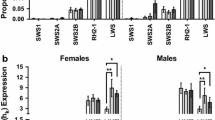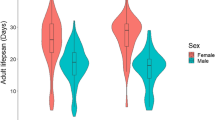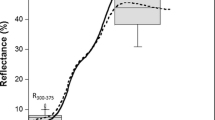Abstract
Several sexual selection theories assume certain benefits of female mate preference. The direct benefit, i.e., the direct contribution from males to their offspring and females, has been well tested empirically. However, the indirect benefit, i.e., the male's genetic contribution to their offspring, has been poorly demonstrated. Female preference for males' carotenoid-based coloration is known in some animals. Since animals must acquire carotenoids through foods, it is often hypothesized that the brightness of the carotenoid-based coloration is a reliable indicator of the male's foraging ability. Hence, females' indirect benefits, such as greater foraging ability in their offspring, through mate preference for the carotenoid-based coloration are assumed. However, the heritability of the foraging ability for foods that serve as carotenoid resources has not been tested. In this study, a maze experiment was performed in guppies (Poecilia reticulata) to examine the heritability of the foraging ability for algae, carotenoid resources in nature. The latency for completing algal-foraging tasks in this experiment showed high individual variation. Heritable estimates of the foraging ability were substantial (h 2 = 0.57 – 0.66) and significant, suggesting a genetic contribution to the foraging ability from fathers to their offspring. This result may support the hypothesis that indirect benefits influence the evolution of female choice.


Similar content being viewed by others
References
Andersson M (1994) Sexual selection. Princeton University Press, Princeton
Brooks R, Endler JA (2001) Direct and indirect sexual selection and quantitative genetics of male traits in guppies (Poecilia reticulata). Evolution 55:1002–1015
Craig JK, Foote CJ (2001) Countergradient variation and secondary sexual color: phenotypic convergence promotes genetic divergence in carotenoid use between sympatric anadromous and nonanadromous morphs of sockeye salmon (Oncorhynchus nerka). Evolution 55:380–391
Endler JA (1980) Natural selection on color patterns in Poecilia reticulata. Evolution 34:76–91
Falconer DS, Mackay TFC (1996) Introduction to quantitative genetics, 4th edn. Longman, London
Grether GF (2000) Carotenoid limitation and mate preference evolution: a test of the indicator hypothesis in guppies (Poecilia reticulata). Evolution 54:1712–1724
Grether GF, Hudon J, Millie DF (1999) Carotenoid limitation of sexual coloration along an environmental gradient in guppies. Proc R Soc Lond B 266:1317–1322
Gwynne DT (1984) Courtship feeding increases female reproductive success in bushcrickets. Nature 307:361–363
Hamilton WD, Zuk M (1982) Heritable true fitness and bright birds: a role for parasites? Science 218:384–387
Hill GE (2002) A red bird in a brown bag: the function and evolution of colorful plumage in the house finch. Oxford University Press, New York
Houde AE (1997) Sex, color, and mate choice in guppies. Princeton University Press, Princeton
Houde AE, Endler JA (1990) Correlated evolution of female mating preferences and male color patterns in the guppy Poecilia reticulata. Science 248:1405–1408
Houde AE, Torio AJ (1992) Effects of parasitic infection on male color pattern and female choice in guppies. Behav Ecol 3:346–351
Johnson K, Dalton R, Burley N (1993) Preferences of female American goldfinches (Carduelis tristis) for natural and artificial male traits. Behav Ecol 4:138–143
Karino K, Haijima Y (2001) Heritability of male secondary sexual traits in feral guppies in Japan. J Ethol 19:33–37
Karino K, Haijima Y (2004) Algal-diet enhances sexual ornament, growth and reproduction in the guppy. Behaviour 141:585–601
Karino K, Shinjo S (2004) Female mate preference based on male orange spot patterns in the feral guppy Poecilia reticulata in Japan. Ichthyol Res 51:316–320
Knapp RA, Kovach JT (1991) Courtship as an honest indicator of male parental quality in the bicolor damselfish, Stegastes partitus. Behav Ecol 2:295–300
Kodric-Brown A (1989) Dietary carotenoids and male mating success in the guppy: an environmental component to female choice. Behav Ecol Sociobiol 25:393–401
Kodric-Brown A, Brown JH (1984) Truth in advertising: the kinds of traits favored by sexual selection. Am Nat 124:309–323
Kokko H, Brooks R, Jennions MD, Morley J (2003) The evolution of mate choice and mating biases. Proc R Soc Lond B 270:653–664
Krinsky NI, Mathews-Roth MM, Taylor RF (1989) Carotenoids; chemistry and biology. Plenum Press, New York
Lozano GA (1994) Carotenoids, parasites, and sexual selection. Oikos 70:309–311
Lynch M, Walsh B (1998) Genetics and analysis of quantitative traits. Sinauer, Sunderland
Milinski M, Bakker TCM (1990) Female sticklebacks use male coloration in mate choice and hence avoid parasitized males. Nature 344:330–333
Møller AP (1994) Sexual selection and the barn swallow. Oxford University Press, Oxford
Olson VA, Owens IPF (1998) Costly sexual signals: are carotenoids rare, risky or required? Trends Ecol Evol 13:510–514
Petrie M (1983) Female moorhens compete for small fat males. Science 220:413–415
Reader SM, Laland KN (2000) Diffusion of foraging innovations in the guppy. Anim Behav 60:175–180
Rutowski RL, Gilchrist GW, Terkanian B (1987) Female butterflies mated with recently mated males show reduced reproductive output. Behav Ecol Sociobiol 20:319–322
Wootton RJ (1998) Ecology of teleost fishes, 2nd edn. Kluwer Academic Publishers, Dordrecht
Zahavi A (1975) Mate selection – a selection for a handicap. J Theor Biol 53:205–214
Acknowledgements
We are grateful to Anne E. Houde, Robert Brooks and anonymous reviewers for critical reading and helpful comments on our manuscript. This work was supported by Grant-in-Aids (#13740436 and #16570012) to K.K. from the Japan Society for the Promotion of Science. This research was performed in compliance with the guideline of the Animal Care and Use Committee of Tokyo Gakugei University as well as that of the Japan Ethological Society.
Author information
Authors and Affiliations
Corresponding author
Additional information
Communicated by K. Lindström
Rights and permissions
About this article
Cite this article
Karino, K., Utagawa, T. & Shinjo, S. Heritability of the algal-foraging ability: an indirect benefit of female mate preference for males' carotenoid-based coloration in the guppy, Poecilia reticulata . Behav Ecol Sociobiol 59, 1–5 (2005). https://doi.org/10.1007/s00265-005-0001-3
Received:
Revised:
Accepted:
Published:
Issue Date:
DOI: https://doi.org/10.1007/s00265-005-0001-3




